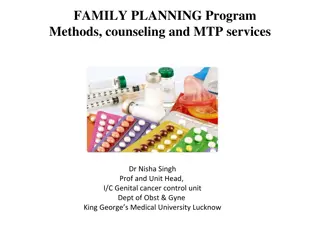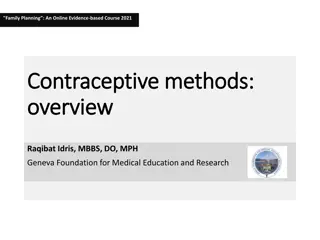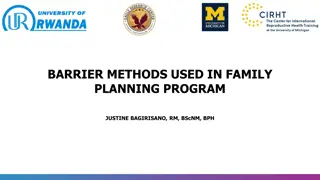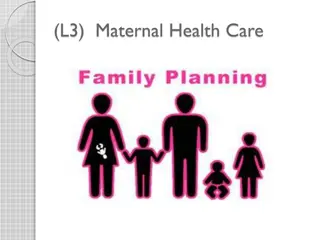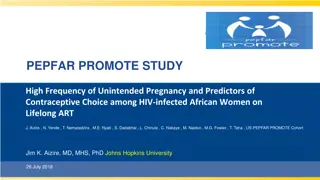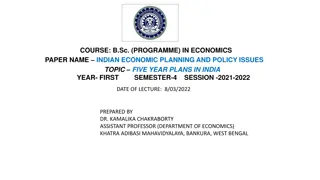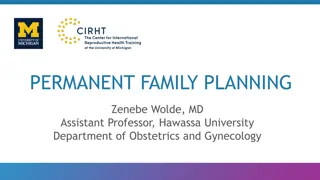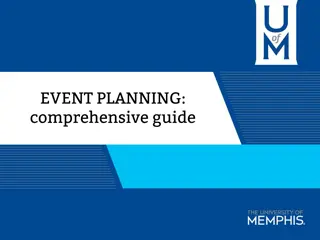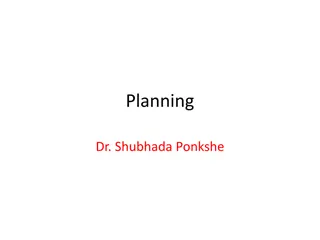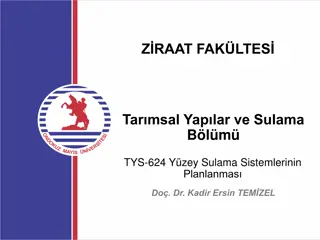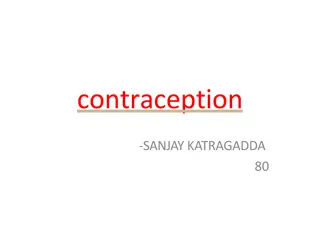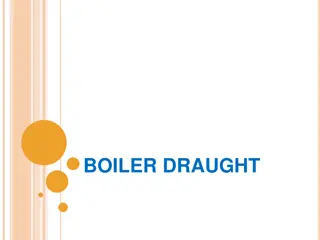Comprehensive Guide to Natural Family Planning Methods
Family planning methods offer individuals control over their fertility through various contraception options, including natural methods like Basal Body Temperature (BBT), Rhythm method, Cervical Mucus/Ovulation method, and Sympto-thermal method. These techniques help in determining the fertile window and aid in family planning without relying on pills or devices. Understanding and utilizing these natural methods can empower individuals in managing their reproductive health effectively.
Download Presentation

Please find below an Image/Link to download the presentation.
The content on the website is provided AS IS for your information and personal use only. It may not be sold, licensed, or shared on other websites without obtaining consent from the author. Download presentation by click this link. If you encounter any issues during the download, it is possible that the publisher has removed the file from their server.
E N D
Presentation Transcript
Family Planning Methods(Control of Fertility) Prof. Dr. Rabea M. Ali
Family Planning Services: Defined as medical activities which enable individuals to determine the number and spacing of their children. "educational, comprehensive
METHODS OF CONTRACEPTION: Natural birth control. Barrier methods, include the diaphragm, cervical cap, male condom, and female condom and spermicidal foam and sponges. Long-acting reversible contraception, such as intra uterine device (IUD). Hormonal contraception, including the birth control pill, the vaginal ring, the contraceptive skin patch. emergency contraception. permanent contraception, such as vasectomy and tubal ligation.
The Natural Family Planning Methods Natural family planning is a form of birth control that doesn't involve pills or devices. As a result, it doesn't have side effects.
Types of Natural Family Planning Basal Body Temperature (BBT) Method: temperature can rise between 0.5 and 1 degree when ovulating. With this method, take temperature before get out of bed each morning, before have anything to eat or drink. BBT by itself isn't a good way to prevent pregnancy because charting temperature tells when ovulation has already happened.
Rhythm method: One of the oldest ways of natural family planning, this is based simply on the calendar. A woman's normal menstrual cycle lasts between 28 and 32 days. Ovulation usually happens around day 14. So must be avoid unprotected sex.
Cervical mucus or ovulation method: check this by gently placing middle finger into vagina and pushing it. For the first few days after period, find vagina is dry and cannot feel any mucus. When ovulating the mucus of cervix is clear, stretchy, and wet, like raw egg whites.
Sympto-thermal method: combine several methods, usually BBT and cervical mucus. Using more than one method can give a better idea what's going on in the body. Breastfeeding: (lactational infertility): gave birth less than 6 months ago, breastfeeding exclusively (no formula, no solid food, only breast milk), haven t had a period since giving birth
Advantages of A Natural Family Planning : It doesn't cause any side effects. Natural family planning is acceptable to all faiths and cultures. Natural family planning can be used either to avoid pregnancy or to become pregnant. It doesn't involve chemicals or physical products. It can help to recognize normal and abnormal vaginal secretions, so can be aware of possible infection. It involves partner in the process, which can help increase feelings of closeness and trust.
Disadvantages: Natural family planning does not protect against STIs such as chlamydia or HIV. need to avoid sex, or use contraception such as condoms, during the time might get pregnant, which some couples can find difficult. It can be much less effective than other methods of contraception if the methods aren't followed accurately. need to keep a daily record of fertility signs. It's not suitable for every woman. Stress, illness, travel, lifestyle and hormonal treatments can disrupt fertility signs
Barrier Methods Barrier Methods: include the diaphragm, male condom, and female condom and spermicidal foam, barrier methods are used only when have sexual intercourse. Be sure to read the instructions before using a barrier method, It is very important that use a barrier method correctly every time have sex. A contraceptive diaphragm: is a circular dome made of thin, soft silicone that's inserted into the vagina before sex.
MALE CONDOM The condom is a rubber sheath worn over the erected penis to prevent sperms from entering the woman's uterus.
The Female Condom: is a birth control (contraceptive) device that acts as a barrier to keep sperm from entering the uterus. The female condom is a soft, loose-fitting pouch with a ring on each end.
Spermicide: is a chemical that inactivates sperm. It comes in different forms, including foams, creams, gels, suppositories.
Advantages of Barrier Methods Protect from STD Do not affect a woman's or man's future fertility. Are only used at the time of sexual intercourse. Are safe for a woman to use while she is breastfeeding. Do not affect other health conditions, such as high blood pressure or diabetes . Are less expensive than hormonal methods of birth control, and some are available without a prescription.
Disadvantages Some couples say that condoms affect the spontaneity of sex. Some feel that there is a decrease in sensation. It can sometimes slip off or split. With the male condom, withdrawal is necessary almost immediately after ejaculation, with care taken not to spill any semen. Some people may be allergic to the condom s latex or plastic, causing discomfort or irritation. A condom can be used only once. Condoms should never be reused.
Intra-Uterine Device "IUD"intrau-terine device." Shaped like a "T", an IUD fits inside uterus. It prevents pregnancy by stopping sperm from reaching and fertilizing eggs. There are 2 types: hormonal and copper.
Hormonal IUD releases the hormone progestin into the body. It prevents pregnancy by making the mucus in cervical canal too thick for sperm to get through, by stopping ovaries from releasing eggs, and by preventing a fertilized egg from attaching to the lining of uterus. The copper IUD is wrapped in thin copper wire that s toxic to sperm. It also keeps a fertilized egg from implanting in the uterus
Advantage of IUD They last a long time. It is highly effective, with a 98-99 percent success rate over five years of IUD use They re safe to use during breastfeeding. Its action lasts for ten years if it is not removed in between It doesn t interfere with intercourse It does not cause weight gain It does not usually affect mood or sex drive
Disadvantages of IUD It doesn t offer any protection against sexually transmitted infections (STIs) There is a slight risk of acquiring uterine infection during IUD insertion within 20 days of the procedure. Uterine perforation may occur during insertion. This may manifest as lower abdominal pain, Perforation will require surgical removal.
Hormonal Contraception There are a number of forms of hormonal contraception, including the birth control pill, contraceptive skin patch The hormones in contraceptives don t only prevent ovulation. fertilized eggs from implanting into the womb. Others cause the mucus in the cervix to become thick and sticky, making it harder for the sperm to move and reach the egg cell. Some also prevent
The Oral Contraceptive Pill The oral contraceptive pill: is a type of birth control that is designed to be taken orally by women. It includes a combination of an estrogen and a progestogen (specifically a progestin).
The Contraceptive Skin Patch The Contraceptive Skin Patch: is about 5 cm in size, and very thin. It can be placed on the woman s behind, belly, the outside of her upper arm. It s important to make sure that it sticks to the skin properly and doesn t rub against clothing too much. Activities like having a shower, a bath or swimming usually don t make it come off.
The Advantages of Hormonal Contraceptives The reliability: Studies have shown that only about 1 out of 1,000 women get pregnant per cycle if they take the pill or use a contraceptive skin patch properly. Hormonal contraceptives can also relieve period pain. If a teenage girl or woman has acne, the hormones may improve her skin too.
Disadvantages of Hormonal Contraceptive Have side effects such as headaches, nausea, and vaginal yeast infections. The hormones can also cause spotting between periods or lead to mood swings, and may reduce women s sexual desire. And there is a small risk of blood clots forming (thrombosis). This risk is higher in women over the age of 40, as well as in women who smoke, are very overweight.
Emergency Contraception Emergency contraception refers to methods of contraception that can be used to prevent pregnancy after sexual intercourse. These are recommended for use within 5 days but are more effective the sooner they are used after the act of intercourse.
In What Situations Can Emergency Contraception be Used? When no contraceptive has been used. Sexual assault when the woman was not protected. Condom breakage, or incorrect use. Three (3) or more consecutively missed combined oral contraceptive pills.
Failed withdrawal (e.g. ejaculation in the vagina or on external genitalia). Expulsion of an intrauterine contraceptive device (IUD) or hormonal contraceptive implant.
Advantages of Emergency Contraception Emergency contraception is safe and effective in preventing pregnancy after unprotected sex. Emergency contraception is private. It is choice if partner knows about it. Emergency contraception is very effective when used early, with only 3% of women becoming pregnant if used within 24 hours of unprotected sexual intercourse.
Disadvantages of Emergency Contraception It does not work if women are already pregnant. It has a limited time frame of 5 days following unprotected intercourse. Women still have a small chance of getting pregnant.
Permanent Contraception Permanent contraception is methods of sterilization that prevent pregnancy permanently. The procedure for men is a vasectomy and for women it is tubal ligation.
A vasectomy : Is a procedure to cut and tie the tubes (vas deferens) that carry the sperm up from the testicles. Men who have had vasectomies still ejaculate and produce semen but since there is no sperm in it, the woman s egg can t be fertilized.
Advantages of Vasectomy Vasectomy are permanent and one of the most effective kinds of birth control out there more than 99% effective at preventing pregnancy. Vasectomy are super convenient, don t have to pay attention to during sex, so it won t interfere with the action
Disadvantage of Vasectomy Vasectomies are meant to be permanent. Even if get vasectomy reversed, fertility may never come back. Vasectomy reversal surgery is complicated and expensive. Vasectomies are very safe, and most people don t have any problems. But all medical procedures have some possible risks. Not protect from STD
Tubal ligation: is a procedure to close both fallopian tubes in a woman. This means that sperm can t get to the egg to fertilise it. The tubes are closed using rings or clips or by cutting and tying.
Advantages: More than 99% effective at preventing pregnancy. Blocking the fallopian tubes and removal of the tubes should be effective immediately but use contraception until next period. It will not affect sex drive or interfere with sex. It will not affect hormone levels.
Disadvantages: It does not protect against STIs. It can fail the fallopian tubes can rejoin and make fertile again, although this is rare. There's a very small risk of complications, including internal bleeding, infection or damage to other organs. If get pregnant after the operation, there's an increased risk it'll be an ectopic pregnancy
Reference Glasier A, Cameron ST, Blithe D, Scherrer B, Mathe H, Levy D, et al. Contraception. 2011 Oct;84(4):363-7. doi: 10.1016/j.contraception.2011.02.009. Epub 2011 Apr 2. (2) Effect of BMI and body weight on pregnancy rates with LNG as emergency contraception: analysis of four WHO HRP studies. Festin MP, Peregoudov A, Seuc A, Kiarie J, Temmerman M. Contraception. 2017 Jan;95(1):50-54. doi: 10.1016/j.contraception.2016.08.001. Epub 2016 Aug 12.
Trussell J, Guthrie KA (2011). Choosing a contraceptive: Efficacy, safety, and personal considerations. In RA Hatcher et al., eds., Contraceptive Technology, 20th ed., pp. 45-74. Atlanta: Ardent Media. Abramowicz M (2010). Choice of contraceptives. Treatment Guidelines From The Medical Letter, 8(100): 89-96. http://www.nhs.uk/Conditions/contraception- guide/Pages/iud-coil.aspx.


